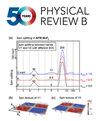由于表面弛豫,Bi(111)表面的拓扑阻塞
IF 3.7
2区 物理与天体物理
Q1 Physics and Astronomy
引用次数: 0
摘要
自三维拓扑绝缘体预测以来,铋及其含Sb合金的拓扑特性引起了激烈的争论。但是,迄今尚未达成一项明确的决议。在这里,我们提供了理论证据,表明表面弛豫掩盖了纯铋的潜在体拓扑结构。利用密度泛函理论计算薄Bi(111)薄膜(多达17个双层),我们首先证明了表面附近双层间的大量膨胀。受这一发现的启发,我们在具有自旋轨道耦合的经验紧密结合模型框架内,将我们的分析扩展到包含松弛层的厚Bi(111)薄膜(多达250层双层)。我们的研究结果表明,这些弛豫层在拓扑上阻止了表面态的出现,并在M¯点显著抑制了表面态的单粒子谱,从而模糊了Bi拓扑性质的实验识别。这种现象,我们称之为“拓扑阻塞”,为观察M¯点Bi(111)表面状态的长期困难提供了重要的见解。此外,它还建立了一个框架,用于理解和预测在表面松弛破坏体边对应的系统中的拓扑行为。2025年由美国物理学会出版本文章由计算机程序翻译,如有差异,请以英文原文为准。
Topological blocking at the Bi(111) surface due to surface relaxation
The topological characteristics of Bi and its alloys with Sb have fueled intense debate since the prediction of three-dimensional topological insulators. However, a definitive resolution has not been reached to date. Here, we provide theoretical evidence that surface relaxation conceals the underlying bulk topology of pure Bi. Using density-functional-theory calculations for thin Bi(111) films (up to 17 bilayers), we first demonstrate a substantial interbilayer expansion near the surface. Motivated by this finding, we extend our analysis to thick Bi(111) films (up to 250 bilayers) incorporating relaxation layers, within the framework of a empirical tight-binding model with spin-orbit coupling. Our results reveal that these relaxation layers topologically block the emergence of a surface state and significantly suppress the one-particle spectrum of surface states at the M¯ point, thereby obscuring the experimental identification of Bi's topological properties. This phenomenon, which we term “topological blocking,” provides crucial insights into the long-standing difficulty of observing surface states of Bi(111) at the M ¯ Published by the American Physical Society 2025
求助全文
通过发布文献求助,成功后即可免费获取论文全文。
去求助
来源期刊

Physical Review B
物理-物理:凝聚态物理
CiteScore
6.70
自引率
32.40%
发文量
0
审稿时长
3.0 months
期刊介绍:
Physical Review B (PRB) is the world’s largest dedicated physics journal, publishing approximately 100 new, high-quality papers each week. The most highly cited journal in condensed matter physics, PRB provides outstanding depth and breadth of coverage, combined with unrivaled context and background for ongoing research by scientists worldwide.
PRB covers the full range of condensed matter, materials physics, and related subfields, including:
-Structure and phase transitions
-Ferroelectrics and multiferroics
-Disordered systems and alloys
-Magnetism
-Superconductivity
-Electronic structure, photonics, and metamaterials
-Semiconductors and mesoscopic systems
-Surfaces, nanoscience, and two-dimensional materials
-Topological states of matter
 求助内容:
求助内容: 应助结果提醒方式:
应助结果提醒方式:


